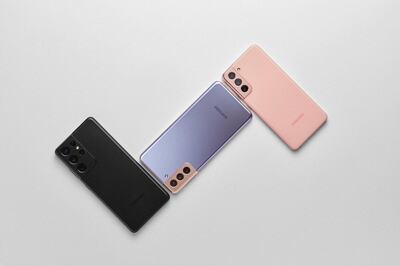South Korean technology company Samsung unveiled its latest 5G-enabled smartphones under the new Galaxy S21 series.
The S21, S21+ and S21 Ultra models come with bigger batteries, advanced computing, greater energy efficiency, improved cameras and enhanced privacy features.
The S21 Ultra will start from Dh4,899. The S21+ and S21 will start from Dh3,999 and Dh3,199, respectively.
The S21 series is the most “powerful and versatile” line-up so far, T M Roh, president and head of Samsung’s mobile communications business, said on Thursday.
“2020 was a year of change ... but through it all, technology kept us connected. In 2021, our top priority is to bring the benefit of technology to more people,” he said.
“From the ultimate experience of super-intelligent, industry-leading pro-grade camera and video capabilities ... to a core flagship experience ... we look forward to offering amazing experiences at a greater value to our consumers.”
With a 17.2-centimetre curved display, the S21 Ultra has four rear cameras: a wide-angle camera with a 108-megapixel lens, an ultra-wide 12-megapixel camera and two telephoto cameras with 10-megapixel lenses each. The front camera has a massive 40-megapixel lens.
Weighing 229 grams, the S21 Ultra is powered by a 5,000 milliampere-hour battery that promises enough power to last for more than a day. It can reach a 50 per cent charge in just 30 minutes, the company said.
Samsung is adding a stylus to the S21 Ultra – a first in the series. Users can either use an existing S Pen from a Note device or buy one separately.
The S21+ weighs 202 grams and has a 17-centimetre flat screen while the S21 weighs 171 grams and has a 15.7-centimetre display.
Both have three cameras on the back – a telephoto camera with a 64-megapixels lens, ultra-wide and wide-angle cameras with 12-megapixel lenses each and a front camera with a 10-megapixel lens.
The S21+ and S21 phones come with 4,800-milliampere-hour and 4,000-milliampere-hour batteries, respectively.

The models also offer larger memory and storage variants – 8 gigabytes of RAM and 128 gigabytes or 256 gigabytes of storage for the S21 and S21+ models.
The S21 Ultra has a RAM that is between 12 gigabytes and 16 gigabytes and storage options of 128 gigabytes, 256 gigabytes and 512 gigabytes.
Samsung expects to boost its first-quarter sales through an early distribution of the latest S21 series.
The company is already taking orders through its website. Those who place their orders will also receive complimentary Galaxy Buds, Samsung said.
As with American rival Apple, Samsung is also not shipping wired headphones and in-box chargers with the S21 series phones, citing sustainability reasons.
“We discovered that more and more Galaxy users are reusing accessories they already have ... making sustainable choices in their daily lives to promote better recycling habits,” said Patrick Chomet, Samsung’s executive vice president and head of customer experience.
The new phones also contain 5-nanometer processor technology that delivers a central processing unit that is 20 per cent faster, a graphics processing unit that is 35 per cent faster and an artificial intelligence framework that is twice as fast.
Ultra-wideband capabilities in the S21 Ultra and S21+ phones can also be used to unlock compatible car doors without the use of keys, the company said.
Samsung is in a battle for dominance in the global smartphone market with Apple and Chinese brand Huawei.
It led the industry with a market share of about 21 per cent market last year and produced 263 million handsets during the period, according to Taipei-based market intelligence company TrendForce.
It was followed by Apple, which produced 199 million handsets and had a market share of 16 per cent, and Huawei, with 170 million handsets and a market share of 14 per cent.




